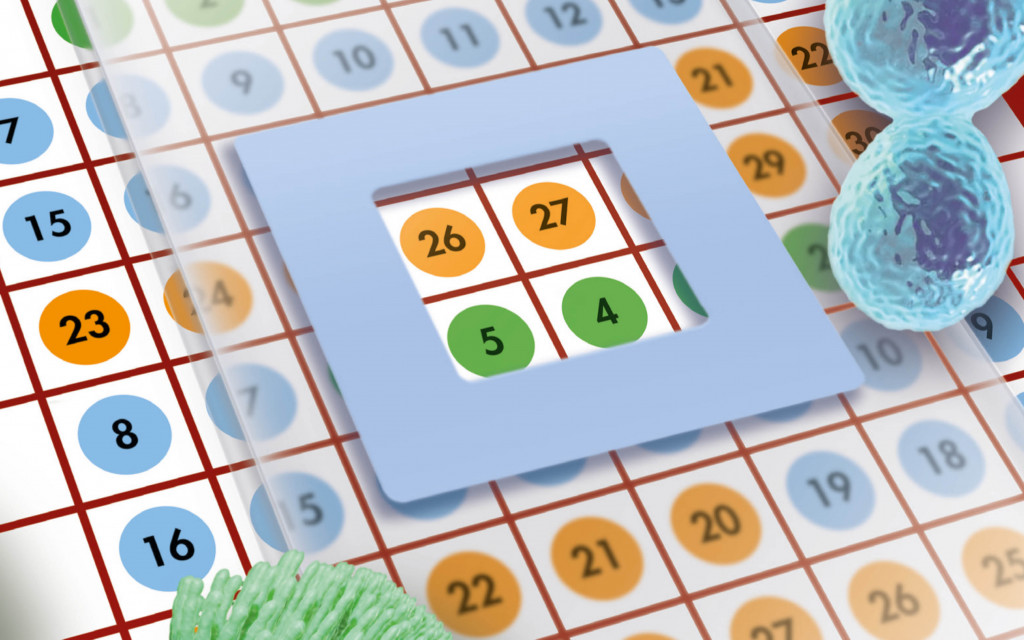PRAME (EPR20330) in dermatopathology
The role of the marker in the differential diagnosis of melanoma
PRAME (PReferentially-expressed Antigen in MElanoma) was first described in a paper by Ikeda et al., through analysis of the specificity of tumor-reactive T-cell clones derived from a patient with metastatic cutaneous melanoma. [1, 2]
PRAME is involved in the regulation of diverse cell biological processes (Fig.1). Based on its categorization as Cancer/Testis Antigen (CTA), it is found almost exclusively in testis, endometrium, placenta, adrenal gland and ovary, while it is absent in other organs. In the pathological context, however, it is found in primary and metastatic melanoma, with the exception of desmoplastic melanoma. [3] Immunohistochemical staining shows mostly diffusely positive tumor tissue. Since normal skin is usually negative for PRAME, detection of PRAME protein is useful as an additional tool to determine the tumor margin. In addition, PRAME is an excellent and reliable marker to differentiate between melanocytic nevi and melanoma. The more dedifferentiated (from atypical nevus to metastatic melanoma) the melanocytes are, the lower the p16 expression rate and the higher the PRAME expression. Thus, approximately 90% of primary invasive melanoma are positive for PRAME, while only 9% are p16 negative. Thus, a cocktail of both markers is ideal for more precise diagnosis. [3] Also, in differentiating nodal nevi from nodal melanoma in sentinel lymph nodes, detection of PRAME shows a significantly higher sensitivity and specificity than the loss of p16. [4] Kaczorowski et al., observe in their study that PRAME is expressed in some melanoma that contain the typical BRAF or NRAS mutations but are negative for the classical markers such as S100 and SOX10. [10] In addition, there is a high level of agreement between results from PRAME IHC and corresponding cytogenetic studies. [5] In mucosal melanoma, strong expression of the marker correlates with poor prognosis.[6] PRAME is an independent prognostic biomarker in uveal melanoma. Here, it is used to identify a higher risk of metastasis in patients with grade 1 categorized tumors. [7, 8] Data suggest that PRAME may represent a potential target for immunotherapy. [9] Recently, data from an ongoing phase 1 cell therapy trial was published (Immatics Press Release, 10/10/2022).
PRAME is not exclusive to melanocytic tumors, but it is also expressed in several other tumor entities, such as rhabdomyosarcoma, breast carcinoma, and Hodgkin's/non-Hodgkin's lymphoma. [9] Only recently data has been published on the expression of PRAME in normal tissue and in more than 5,800 different tumors in the American Journal of Surgical Pathology. [10] In contrast to previous mRNA-based studies, this work is based on immunohistochemical experiments. Because immunohistochemistry is a reliable and comparatively inexpensive method, the authors discuss the detection of PRAME in diverse tumor entities with regard to potential immunotherapy.
A paper by Takata et al., 2022 demonstrates a dual function of PRAME in the pathogenesis of Diffuse Large B-Cell Lymphoma (DLBCL). [11] The absence of PRAME resulted in T cell immune escape. This can be reversed by inhibition of the repression complex with restoration of the PRAME protein. [11] This mechanism is discussed in terms of potential therapeutic approaches in certain lymphoma patients.
Products
| Product | Manufacturer | Clone | Amount | Status | Order no. | Info | ||||||||||||||||||||
|---|---|---|---|---|---|---|---|---|---|---|---|---|---|---|---|---|---|---|---|---|---|---|---|---|---|---|
|
EPR20330 | 1 ml | Concentrate | CE/IVD | RMAB109 | |||||||||||||||||||||
|
EPR20330 | 0.1 ml | Concentrate | CE/IVD | RMAB109-01 | |||||||||||||||||||||
|
EPR20330 | 0.5 ml | Concentrate | CE/IVD | RMAB109-05 | |||||||||||||||||||||
|
EPR20330 | 6 ml | Ready-to-use | CE/IVD | RMPD109 | |||||||||||||||||||||
|
EPR20330 | 0.1 ml | Concentrate | CE/IVD | ACI3252A | |||||||||||||||||||||
|
EPR20330 | 0.5 ml | Concentrate | CE/IVD | ACI3252B | |||||||||||||||||||||
|
EPR20330 | 6 ml | Ready-to-use | CE/IVD | API3252AA | |||||||||||||||||||||
|
BC42+EPR20330 | 6 ml | Ready-to-use | CE/IVD | API3256DSAA | |||||||||||||||||||||
|
EPR20330 | 7 ml | Ready-to-use | CE/IVD | ALI3252G7 |
Bibliography
- [1] Ikeda H, Lethe B, Lehmann F, et al. Characterization of an antigen that is recognized on a melanoma showing partial HLA loss by CTL expressing an NK inhibitory receptor. Immunity 1997;6(2):199e208.
- [2] Kirkin AF, Dzhandzhugazyan K, Zeuthen J. Melanoma-associated antigens recognized by cytotoxic T lymphocytes. APMIS 1998;106(7):665e679.
- [3] Lezcano C, Jungbluth AA, Nehal KS, et al. PRAME expression in melanocytic tumors. Am J Surg Pathol 2018;42(11):1456e1465.
- [4] See SHC, Finkelman BS, Yeldandi AV. The diagnostic utility of PRAME and p16 in distinguishing nodal nevi from nodal metastatic melanoma. Pathol Res Pract 2020;216(9):153105.
- [5] Lezcano C, Jungbluth AA, Busam KJ. Comparison of immunohistochemistry for PRAME with cytogenetic test results in the evaluation of challenging melanocytic tumors. Am J Surg Pathol 2020;44(7):893e900.
- [6] Toyama A, Siegel L, Nelson AC, et al. Analyses of molecular and histopathologic features and expression of PRAME by immunohistochemistry in mucosal melanomas. Mod Pathol 2019;32(12):1727e1733.
- [7] Field MG, Decatur CL, Kurtenbach S, et al. PRAME as an independent biomarker for metastasis in uveal melanoma. Clin Cancer Res 2016;22(5):1234e1242.
- [8] Field MG, Durante MA, Decatur CL, et al. Epigenetic reprogramming and aberrant expression of PRAME are associated with increased metastatic risk in Class 1 and Class 2 uveal melanomas. Oncotarget. 2016;37(7):59209e59219.
- [9] Xu Y, Zou R, Wang J, et al. The role of the cancer testis antigen PRAME in tumorigenesis and immunotherapy in human cancer. Cell Prolif 2020;53(3):e12770.
- [10] Kaczorowski M, Chlopek M, Kruczak A, et al. PRAME Expression in Cancer. A Systematic Immunohistochemical Study of >5800 Epithelial and Nonepithelial Tumors. Am J Surg Pathol 2022;46(11):1467e1476.
- [11] Takata K, Chong LC, Ennishi D, et al. Tumor-associated antigen PRAME exhibits dualistic functions that are targetable in diffuse large B cell lymphoma, J Clin Invest 2022;132(10):e145343.
Further topics

News about the IVDR
The IVDR, in force since May 26, 2022, represents a turning point in the EU-wide harmonization of patient safety. At the same time, it places high demands on us as manufacturers and on you as a user of in vitro diagnostic medical devices to implement the new regulation. We would like to meet this challenge together with you for the benefit of your patients. It is important to us to certify our portfolio of diagnostic solutions in compliance with the IVDR in due time. Therefore, we would like to keep you informed about our progress with the implementation of the IVDR.

Exciting news!
After months of intensive work, we are pleased to announce the launch of our latest product innovation expanding the VisionArray® product family: The VisionArray® FUNGI Chip 1.0!
